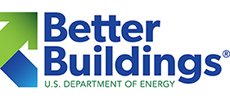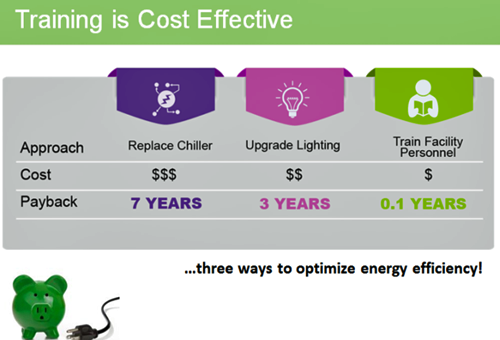Introduction
Within This Page
Investing in a well-trained workforce is absolutely critical to achieving and maintaining high-performance buildings and efficient operations. Recent studies indicate that most any building can cut 5–30% off its operating costs through improved operations and maintenance. Even relatively well-run buildings or buildings that have been upgraded recently may have significant savings. Key to realizing this is ensuring that employers and employees alike understand the knowledge, skills, and abilities necessary to achieve these goals and make an investment in education and training to achieve them.
As a result, requirements for federal facilities including the Federal Buildings Personnel Training Act (FBPTA) and other programs like the Better Buildings Workforce Guidelines effort have been issued to ensure that employers, employees, and educators and credentialing bodies understand the critical professional competencies necessary to achieve these goals. This page provides an overview and introduction to several programs and resources that can help each of the following:

-
Workers—learn what knowledge, skills and abilities you need to have to do your particular job and find the training and credentialing resources to gain them, and, do the same for the job you want to work towards in your future career.
-
Employers—understand how to build a talent management program that ensures your team has the right knowledge skills and abilities to meet its facilities goals; find the right training, professional credentials and other resources that signify worker competency in managing, maintaining, evaluating, creating high performing and efficient buildings.
-
Provider Organizations see what is available and how to use resources to help their members/students improve skills, achieve proficiency, gain recognition and qualify for jobs.
The material in this page is organized to help you find the resources and specific materials to help you identify your specific needs.
-
Understand the competencies needed for a high-performance building and how BBWG and other FBPTA-aligned courses and credentials can help address those competencies
- Career Map—How does one get from where they are now (common job titles) to where they want to be (future job titles) and how can the BBWG credentials help
- Introduce people in current positions at a particular building management office, or, people from the Career Map
-
How can you build the business case for training?
-
Back to the building story—How can people use these tools to build the case for the time and funding to take training and complete credentials?
-
Call to action—A well trained workforce is critical to achieving and maintaining high-performance buildings and organizational sustainability goals.
-
Identify your training needs. Use these tools to help you do that!
- Career Map—How does one get from where they are now (common job titles) to where they want to be (future job titles) and how can the BBWG credentials help
Description

This page is intended to promote workforce development in one place providing information for Workers, Employers, and Provider Organizations and the resources necessary to meet their specific needs and requirements. The following programs are reviewed in this page. Click on the links for more specific information and requirements.
- Federal Buildings Personnel Training Act
- Better Buildings Workforce Guidelines
- Competency Model Clearinghouse
- Facility Management and Operations Council (FMOC)
- Sustainable Facilities Tool
- Whole Building Design Guide
- Accelerate FM
- Federal Facilities Skills Assessment Tool
- Green Buildings Career Map

Federal Buildings Personnel Training Act (FBPTA) Program—The FBPTA became law in 2010. It required the General Services (GSA) to develop a set of Core Competencies for Federal Buildings Personnel (those involved in building operations and maintenance, energy management, safety and design) and to identify a Curriculum of courses, credentials, licenses and degrees that would ensure those competencies are met. The requirements of this Act are applicable to non-federal buildings personnel performing these functions under contract with a federal agency.
-
Workers—Identify the specific competencies you need to achieve the requirements of the Act as identified by your agency or employer and, locate the training and credentialing to meet those requirements. Use these resources to plan your professional development and justify your request for training.
-
Employers—Build a high-performance team by identifying the skills that each individual needs to have, and designing a training plan for your employees to follow to gain them. Use tools to communicate requirements to employees and track the progress of your organization over time.
-
Provider Organizations—Understand the competency requirements established by the federal government and find tools to help demonstrate how your products meet those requirements. BBWG Approved credentials have already demonstrated those requirements.

Better Buildings Workforce Guidelines (BBWG)—Improving the operational performance of the nation's offices, schools, hospitals, and other commercial buildings offers significant energy savings. It also requires highly skilled and qualified workers, particularly as building technologies become more advanced. Through the Better Buildings Workforce Guidelines, industry now has national guidelines from which to develop high quality and nationally recognized training and certification programs, helping to address challenges found in the energy efficiency workforce with quality, consistency, and scalability across certification and certificate programs.
-
Workers—Information
-
Employers—Information list of recognized
-
Provider Organizations—Information and instruction on recognition
Competency Model Clearinghouse—Energy: Advanced Commercial Buildings Competency
-
Workers—N/A
-
Employers—Look at for background for human resources (HR)
-
Provider Organizations—How to build curriculum

The National Institute of Building Sciences and the U.S. Department of Energy (DOE) have developed voluntary national guidelines, known as the Better Buildings Workforce Guidelines (BBWG), to improve the quality and consistency of commercial building workforce credentials. NIBS established the Commercial Workforce Credentialing Council (CWCC) now as a committee under the Facility Management and Operations Council (FMOC) to lead development of those guidelines. Improving the operational performance of commercial buildings requires highly skilled and qualified workers, particularly as building technologies become more advanced. Yet the lack of national guidelines for energy-related professional credentials represents a major barrier to the quality, consistency and scalability of this workforce. The BBWG will initially address commercial building workforce training and certification programs for four key energy-related jobs: building energy auditor, building commissioning professional, energy manager and building operations professional.
-
Workers—Informational, can see JTA
-
Employers—Informational
-
Provider Organizations—Primary user, get JTA, how to get accredited, recognized, participate

Sustainable Facilities Tool (SFTool)—is an online resource that helps Federal Agencies and the general public buy, build and operate green. User guides that are tailored to specific professional roles take the learner directly to the topics that interest them the most.
-
Workers—Find detailed resources on many of the topics you need to know when operating high-performance buildings. The site is intuitive and easy to navigate with topics and information tailored and focused to the needs of your role in the organization. Find explanations of complex topics and annotated versions of various federal regulations that lay out what you need to do. Use the FEDSAT module of SFTool to demonstrate basic FBPTA compliance
-
Employers—Help your employees find the information they need for their role and the information you need to ensure your organization is operating its facilities at optimum capacity. Use the FEDSAT tool to help your employees find free training to fill basic knowledge gaps and to help you demonstrate that your workforce has achieved basic compliance with the FBPTA.
-
Provider Organizations—Consider using SFTool as a place to show how your resources and knowledge base contribute to the knowledge, skills and abilities needed by buildings personnel. Free resources may be linked to directly from SFTool or FEDSAT to support the continuing education needs of the personnel that operate and maintain the large federal portfolio.

Whole Building Design Guide (WBDG) Continuing Education—The WBDG contains a wealth of information and is the gateway to up-to-date information on integrated 'Whole Building Design' Techniques and Technologies. The courses featured offer an introduction to Whole Building Design concepts as well as more specific applications for design objectives, building types, and operations and maintenance.
-
WBDG Courses
The content in the WBDG courses is developed by top experts in the fields of architecture, engineering, planning, facility management, and facility energy management, among others. So you can be assured that the information is up-to-date and relevant, and will inspire you to engage in the process of Whole Building Design, contributing to the stock of America's building. - FEMP Courses
The U.S. Department of Energy Federal Energy Management Program (FEMP), through a partnership with the National Institute of Building Sciences, offers FEMP E-Learning Courses and First Thursday Seminars on the Whole Building Design Guide (WBDG).- E-Learning Courses are interactive, on-demand, self-paced, and self-tracking courses are supportive of the Federal Building Personnel Training Act competencies and will provide up-to-date information targeted to mid-level Federal Energy, Water, and Sustainability Managers. Their course ids are formatted FEMPXX.
- First Thursday Seminars provide training for Federal energy and environmental professionals. Leading experts address timely topics in 90-minute sessions. Their course ids are formatted FEMPFTSXX.
- FEMP also offers Certificate Series that allow learners to reach a higher level of expertise in certain series topic areas by taking a grouping of courses.
-
Workers—Get free training courses, FEMP and others
-
Employers—Direct workers here for training
-
Provider Organizations—Offer courses

Accelerate FM (AFM)—Helps organizations and individuals understand the requirements of the FBPTA and set up a competency-based workforce development program to meet them.
-
Workers—If you are a federal employee or contractor working on a federal contract, pick your job from a list of "position profiles" and find the skills you need to comply with the FBPTA and any additional requirements set by your organization. Search for training and credentials to meet those needs.
-
Employers—Build a high-performance team by assigning specific FBPTA competencies to each position in your company and designing a professional development plan based on the courses, credentials and other FBPTA-Aligned resources that meet them. Use the tool to communicate these requirements to employees and track the progress of your organization over time.
-
Provider Organizations—Learn how to demonstrate how your products align with the FBPTA and market those products to the employees and employers serving the large federal buildings portfolio.

Federal Facilities Skills Assessment Tool (FEDSAT)—FEDSAT is a simple open-book test that identifies your strengths and weaknesses with basic knowledge deemed critical for all buildings personnel. Wherever you miss a question you will be led to free, online training and resources tied to that topic. You can take the test over multiple sittings as you have time and can retake questions until you get a perfect score. A perfect completion demonstrates that you have met the most basic requirements of the FBPTA. FEDSAT is built within the GSA Sustainable Facilities Tool, which provides great information on how to build, buy, and operate green buildings. SFTool can be easily accessed from your computer, tablet or mobile phone so you can do FEDSAT anytime, anywhere. FEDSAT completion also demonstrates basic compliance with the Federal Buildings Personnel Training Act.
-
Workers—Use FEDSAT to identify the knowledge you need in any role involved in operating and maintaining buildings. Identify areas where you need work and find free, online resources to strengthen your knowledge. Though FEDSAT was designed primarily for federal workers employees/contractors the topics covered will be valuable for all buildings personnel.
-
Employers—Help your employees know what they don't know and find free resources to address their areas of weakness. You can use FEDSAT to demonstrate that your high-performance team has met the most basic requirements of the FBPTA and
-
Provider Organizations—N/A

Green Buildings Career Map—The Map is a highly interactive tool developed in partnership with the Interstate Renewable Energy Council (IREC) that explores careers in green buildings and energy efficiency, one of the fastest growing industries in the U.S. and around the world. Demand for energy efficiency and green building jobs are growing as well. The Map covers 55 careers across four major sectors of the green buildings and energy efficiency industry, charting over 300 possible progression routes between those occupations, and identifying the credentials necessary to do them well. These 55 jobs have a mission to design, build, and operate high-quality, healthier, more energy efficient homes, and commercial and industrial buildings. The Map is designed for educators, career-advisors, jobseekers, employers, policymakers, and workforce professionals.
-
Workers—Identify the specific skills, training, or certifications needed to support the green building industry at an entry, mid-level, or advanced level.
-
Employers—Build a green team by identifying the skills, training, and certifications that individuals need to compete in the green building industry, and create a training plan for employees to follow.
-
Provider Organizations—Become a leader in the green building industry by accessing and sharing Map information about trade and industry associations, energy efficiency advocacy groups, certification bodies, government agencies, education/career counseling organizations, green building opportunities, and more.

The following two case studies demonstrate the success of workforce development plans that were implemented at both an individual and program level.








